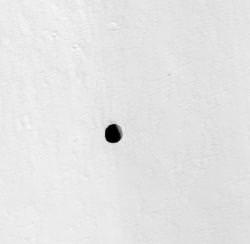Remember those amazing images of open pits on Mars? NASA’s Mars Reconnaissance Orbiter has come back around and taken another image of one of the features, and this time it spotted a wall on one side. This wall indicates that these “pits” are probably tunnels, similar to surface features on Earth called “pit craters”.
The new images were captured with the orbiter’s High Resolution Imaging Experiment (HiRISE), the most powerful camera ever to orbit another planet. It first noticed the features on May 5th, 2007. In its original image, MRO captured a photo from almost directly overhead, and saw only darkness. This time around, on August 8th, it captured the image from the west, when the Sun was also shining at an angle, revealing a wall on the eastern side of the pit.
The rim of the pit is 150 by 157 metres across. And the new image shows that the depth is at least 78 metres deep.
Here on Earth, you can find pit craters in Hawaii, around the Kilauea Volcano. They’re circular-shaped craters that are believed to form when a magma lake empties out underneath. The crusty top then collapses down forming a bowl shaped crater. For example, here’s a link to an image of a pit crater in Hawaii.
This isn’t the first time that pit craters have been seen on Mars. For example, here’s another image captured by HiRISE of pits along the floor of Cyane Fossae, a set of fissures between the giant volcanoes Olympus Mons and Alba Patera. These fissures formed when the surface of Mars was being stretched by volcanic activity, causing underground voids to collapse. But these are much shallower than the newly discovered “pit”.
New Scientist is covering this story from the angle that these pits could serve a refuge for astronauts, protecting them from the dangerous ultraviolet radiation streaming from the Sun. Unlike the Earth, Mars has no protective ozone layer that blocks ultraviolet radiation. These pits could provide a wall of nice protective dirt, assuming they remain in the shadows.
I’m sure we’ll hear more on this story in the weeks and months to come. It’s very exciting.
Original Source: University of Arizona News Release

